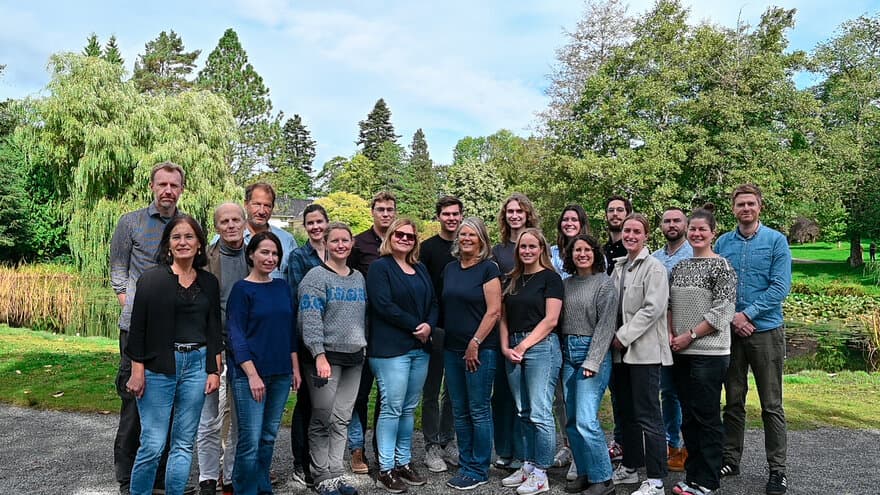About the research group
Our research on the microbial N-cycle
Our main focus is microorganisms that drive the biogeochemical nitrogen cycle, which involves a number of processes in which nitrogen is transformed in different redox reactions. Some types of bacteria and archaea are capable of “fixing” nitrogen (N2) from the atmosphere and reducing it to ammonia, which can be used by most living organisms to make amino acids and proteins. When the organisms die, the organic nitrogen is degraded and the reactive nitrogen that is released will go through a series of processes and finally be released back to the atmosphere as nitrogenous gases. Most will be harmless N2, but some will be emitted as N2O, a potent greenhouse gas that also destroys the stratospheric ozone layer. The reduction of N2O to N2, the final step of the N-cycle, is therefore crucial.
Only one enzyme is known to reduce N2O. This enzyme, N2O reductase, is carried solely by prokaryotes, some of which are also sources of N2O, chiefly via denitrification.
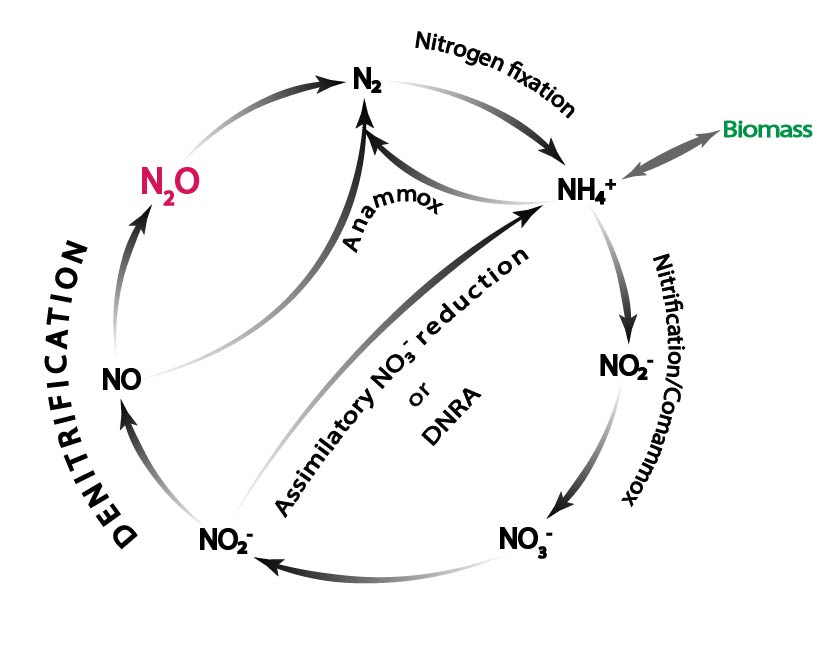
Our research has provided several crucial pieces of knowledge to the understanding of how microorganisms regulate their production and reduction of N2O. Our studies include both basic and applied research and include all scales “from molecules to the field” or, in other words, from enzymes to complex microbial communities (microbiomes)” in soils and in engineered systems such as wastewaters and biogas fermenters.
Our basic research and recent biotechnological advances all fall in line with our mission, which is to contribute to sustainable food and feed production for a growing world population.
Basic research
Our ongoing basic research projects aim to better understand how denitrifying organisms handle environmental stresses. Although many nuts and bolts of the regulatory networks involved in denitrification have been unraveled, the current knowledge is mostly based on laboratory studies of organisms growing under optimal conditions, while surprisingly little is known about the regulation of denitrification in bacteria living under natural conditions.
In the recently started project STARVOX we will study how starvation (lack of carbon substrate) and oxidative stress influences the regulation of denitrification in different bacteria, with a focus on effects on N2O emission. Another ongoing basic research project (N2Air) follows up our discovery that the negative correlation seen between soil pH and N2O emissions is due to the organisms having problems with producing functional N2O reductase in acidic environments and dives deeper into the enzyme structure to determine if the problem lies in an inability of the bacteria to insert Cu-ions into the active center of the enzyme when pH is below 6.
Applied research
Years of basic research have equipped us with the knowledge to explore biotechnological applications.
We are currently developing:
- A novel process for single-cell protein production by denitrification (projects: AnaPro and VERIAN).
- Novel methods to mitigate N2O emissions from agricultural soils, by manipulating the soil microbiome to become a sink for N2O:
- - Enrichment of digestates, derived from biogas production with N2O reducing bacteria, with very promising results
- -Inoculation of legumes with bacteria (rhizobia) that not only increase their N2-fixation capacity but that are also strong sinks for N2O.
News
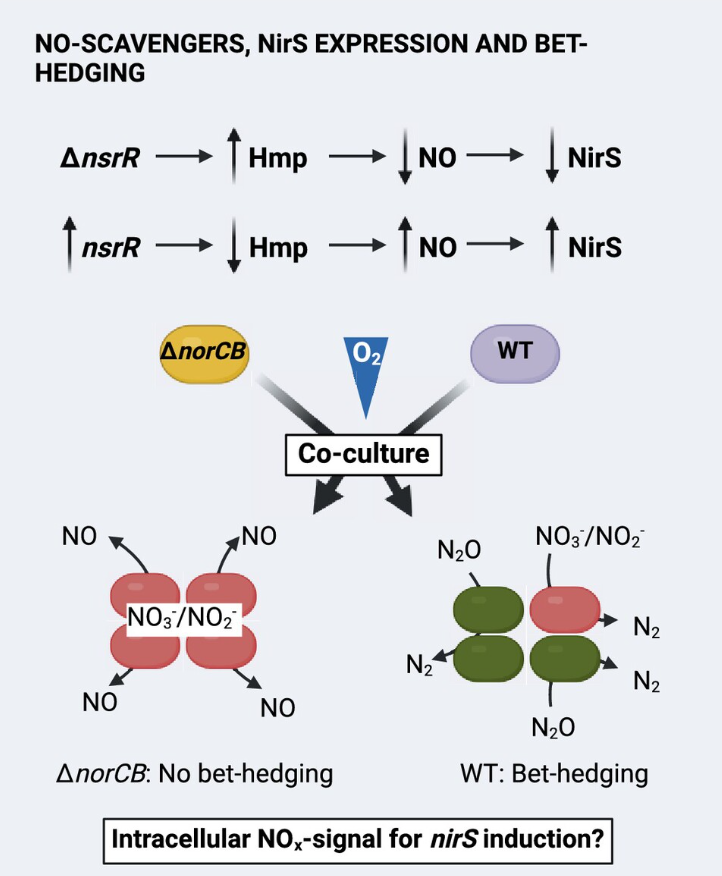
18.03.2025
New publication!
The NMBU Nitrogen-group's newest publication is a collaborative work between NMBU, the University of Texas and the University of East Anglia. It explores the relationship of the flavohemoglobin Hmp and bet-hedging strategy of Paracoccus denitrificans. It is shown that Hmp scavenges NO in aerobic cultures and as such has a negative effect on initial nir expression which is important for controlling the transition to anaerobic respiration.
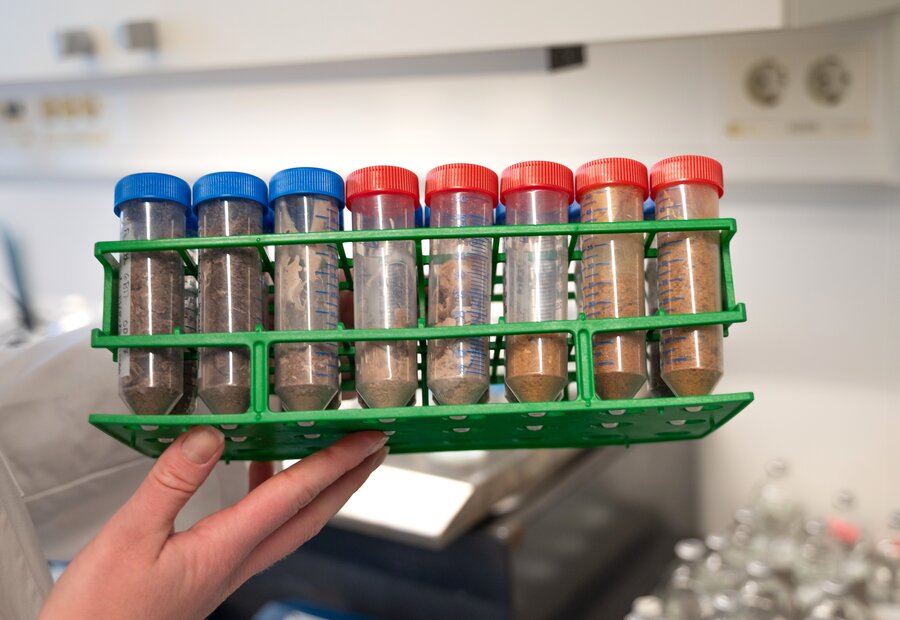
28.01.2025
Forskning.no wrote article about AnaPro!
Forskning.no, the Norwegian online newspaper for national and international research news picked up the story of AnaPro. Highlighting that in the future, protein powder might be produced from high cell density cultivation using denitrification.
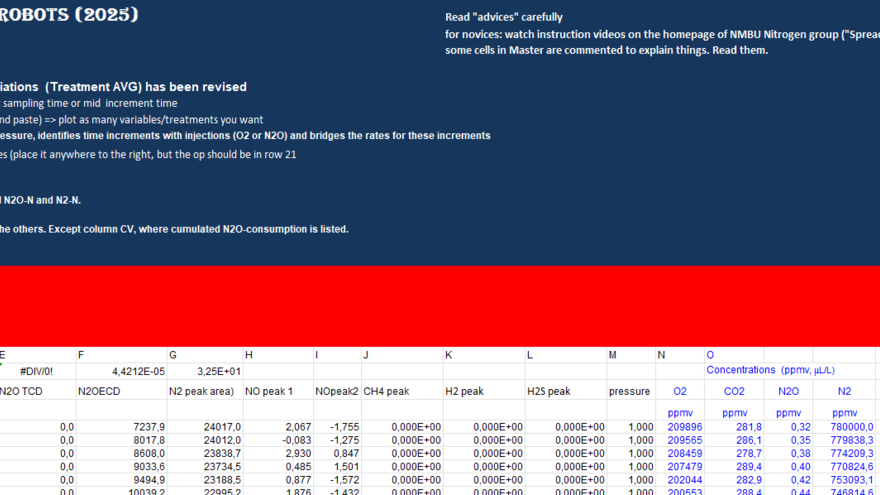
28.01.2025
New version of kincalc!
A new version of kincalc has been uploaded, see links under "Gas Kinetics Analysis". Instructions for use of spreadsheet are in the videos attached to links as well as in the spreadsheet itself.
Publications
For more comprehensive publication list, see NMBU N-group2025
Kellermann, R., Kumar, S., Gates, A.J., Bakken, L.R., Spiro, S., Bergaust, L.L.
The Flavohemoglobin Hmp and Nitric Oxide Reductase Restrict Initial nir Expression in the Bet-Hedging Denitrifier Paracoccus denitrificans by Curtailing Hypoxic NO Signalling. (Environmental Microbiology)
2024
Maråk, M.M., Kellermann, R., Bergaust, L.L., Bakken, L.R.
High cell density cultivation by anaerobic respiration. (Microbial Cell Factories)
https://doi.org/10.1186/s12934-024-02595-8
Crowther, T.W., Rappuoli, R., Corinaldesi, C., Danovaro, R., Donohue, T.J., Huisman, J., Stein, L.Y., Timmis, J.K., Timmis, K., Anderson, M.Z., Bakken, L.R., Baylis, M., Behrenfeld, M.J., Boyd, P.W., Brettell, I., Cavicchioli, R., Delavaux, C.S., Foreman, C.M., Jansson, J.K., Koskella, B., Milligan-McClellan, K., North, J.A., Peterson, D., Pizza, M., Ramos, J.L., Reay, D., Remais, J.V., Rich, V.I., Ripple, W.J., Singh, B.K., Smith, G.R., Stewart, F.J., Sullivan, M.B., van den Hoogen, J., van Oppen, M.J.H., Webster, N.S., Zohner, C.M., van Galen, L.G.
Scientists' call to action: Microbes, planetary health, and the Sustainable Development Goals. (Cell)
https://doi.org/10.1016/j.cell.2024.07.051
Sennett, L.B., Roco, C.A., Lim, N.Y.N., Yavitt, J.B., Dörsch, P., Bakken, L.R., Shapleigh, J.P., Frostegård, Å.
Determining how oxygen legacy affects trajectories of soil denitrifier community dynamics and N2O emissions. (nature communications)
https://doi.org/10.1038/s41467-024-51688-w
Hiis, E.G., Vick, S.H.W., Molstad, L., Røsdal, K., Jonassen, K.R., Winiwarter, W., Bakken, L.R.
Unlocking bacterial potential to reduce farmland N2O emissions. (nature)
2023
Gao, Y., Øverlie Arntzen, M., Kjos, M., Bakken, L.R., Frostegård, Å.
Denitrification by Bradyrhizobia under Feast and Famine and the Role of the bc1 Complex in Securing Electrons for N2O Reduction. (Applied and Environmental Microbiology)
https://doi.org/10.1128/aem.01745-22
Highton, M.P., Bakken, L.R., Dörsch, P., Tobias-Hunefeldt, S., Molstad, L., Morales, S.E.
Soil water extract and bacteriome determine N2O emission potential in soils. (Biology and Fertility of Soils)
https://doi.org/10.1007/s00374-022-01690-5
Kellermann, R., Vick, S.H.W., Lindtveit, K., Milligan, D.A., Bergaust, L.L.
Cell density dependent restriction of N2O reductase in denitrifying Pseudomonas spp., a potential driver of N2O emissions in natural systems. (FEMS Microbiology Letters)
https://doi.org/10.1093/femsle/fnad055
Li, H., Song, X., Bakken, L.R., Ju, X.
Reduction of N2O emissions by DMPP depends on the interactions of nitrogen sources (digestate vs. urea) with soil properties. (Journal of Integrative Agriculture)
https://doi.org/10.1016/j.jia.2022.08.009
Lücker, S., Lenferink, W., Bakken, L., Jetten, M., Kessel, M.V.
Hydroxylamine production by Alcaligenes faecalis challenges the paradigm of heterotrophic nitrification. (Preprint, Research Square)
https://doi.org/10.21203/rs.3.rs-3352161/v1
Vick, S.H.W., Jonassen, K.R., Arntzen, M.Ø., Lycus, P., Bakken, L.R.
Meta-omics analyses of dual substrate enrichment culturing of nitrous oxide respiring bacteria suggest that attachment and complex polysaccharide utilisation contributed to the ability of Cloacibacterium strains to reach dominance. (Preprint, BioRxiv)
https://doi.org/10.1101/2023.06.04.543644
Wang, X., Xiang, B., Li, J., Zhang, M., Frostegard, A., Bakken, L., Zhang, X.
Using adaptive and aggressive N2O-reducing bacteria to augment digestate fertilizer for mitigating N2O emissions from agricultural soils. (Science of the Total Environment)
https://doi.org/10.1016/j.scitotenv.2023.166284
Yoon, S., Heo, H., Han, H., Song, D.U., Bakken, L.R., Frostegård, Å., Yoon, S.
Suggested role of NosZ in preventing N2O inhibition of dissimilatory nitrite reduction to ammonium. (mBio)
2022
Duffner, C., Kublik, S., Fösel, B., Frostegård, Å., Schloter, M., Bakken, L., Schulz, S.
Genotypic and phenotypic characterization of hydrogenotrophic denitrifiers. (Environmental Microbiology)
https://doi.org/10.1111/1462-2920.15921
Frostegård, Å., Vick, S.H., Lim, N.Y., Bakken, L.R., Shapleigh, J.P.
Linking meta-omics to the kinetics of denitrification intermediates reveals pH-dependent causes of N2O emissions and nitrite accumulation in soil. (The ISME Journal)
https://doi.org/10.1038/s41396-021-01045-2
Jonassen, K.R., Hagen, L.H., Vick, S.H., Arntzen, M.Ø., Eijsink, V.G., Frostegård, Å., Lycus, P., Molstad, L., Pope, P.B., Bakken, L.R.
Nitrous oxide respiring bacteria in biogas digestates for reduced agricultural emissions. (The ISME Journal)
https://doi.org/10.1038/s41396-021-01101-x
Jonassen, K.R., Ormåsen, I., Duffner, C., Hvidsten, T.R., Bakken, L.R., Vick, S.H.W.
A Dual Enrichment Strategy Provides Soil- and Digestate-Competent Nitrous Oxide-Respiring Bacteria for Mitigating Climate Forcing in Agriculture. (mBio)
https://doi.org/10.1128/mbio.00788-22
Kellermann, R., Hauge, K., Tjåland, R., Thalmann, S., Bakken, L.R., Bergaust, L.
Preparation for Denitrification and Phenotypic Diversification at the Cusp of Anoxia: a Purpose for N2O Reductase Vis-à-Vis Multiple Roles of O2. (Applied and Environmental Microbiology)
https://doi.org/10.1128/aem.01053-22
Lekberg, Y., Bååth, E., Frostegård, Å., Hammer, E., Hedlund, K., Jansa, J., Kaiser, C., Ramsey, P.W., Řezanka, T., Rousk, J., Wallander, H., Welc, M., Olsson, P.A.
Fatty acid 16:1ω5 as a proxy for arbuscular mycorrhizal fungal biomass: current challenges and ways forward. (Biology and Fertility of Soils)
https://doi.org/10.1007/s00374-022-01670-9
Mousavi, S.A., Gao, Y., Penttinen, P., Frostegård, Å., Paulin, L., Lindström, K.
Using amplicon sequencing of rpoB for identification of inoculant rhizobia from peanut nodules. (Applied Microbiology)
2021
Gao, Y., Mania, D., Mousavi, S.A., Lycus, P., Arntzen, M.Ø., Woliy, K., Lindström, K., Shapleigh, J.P., Bakken, L.R., Frostegård, Å.
Competition for electrons favours N 2 O reduction in denitrifying Bradyrhizobium isolates. (Environmental Microbiology)
https://doi.org/10.1111/1462-2920.15404
Ruiz, B., Frostegård, Å., Bruand, C., Meilhoc, E.
Rhizobia: highways to NO. (Biochemical Society Transactions)
https://doi.org/10.1042/BST20200989
Svennevik, O.K., Jonassen, K.R., Svensson, K., Hagen, L.H., Westereng, B., Solheim, O.E., Nilsen, P.J., Horn, S.J., Bakken, L.
Protecting Thermally Hydrolyzed Biosolids from Pathogenic Bacterial Growth by Addition of Compost. (Waste and Biomass Valorization)
2020
Angell, I.L., Bergaust, L., Hanssen, J.F., Aasen, E.M., Rudi, K.
Ecological Processes Affecting Long-Term Eukaryote and Prokaryote Biofilm Persistence in Nitrogen Removal from Sewage. (Genes)
https://doi.org/10.3390/genes11040449
Bakken, L.R., Frostegård, Å.
Emerging options for mitigating N2O emissions from food production by manipulating the soil microbiota. (Current Opinion in Environmental Sustainability)
https://doi.org/10.1016/j.cosust.2020.08.010
Highton, M.P., Bakken, L.R., Dörsch, P., Wakelin, S., de Klein, C.A., Molstad, L., Morales, S.E.
Soil N2O emission potential falls along a denitrification phenotype gradient linked to differences in microbiome, rainfall and carbon availability. (Soil Biology and Biochemistry)
https://doi.org/10.1016/j.soilbio.2020.108004
Keuschnig, C., Gorfer, M., Li, G., Mania, D., Frostegård, Å., Bakken, L., Larose, C.
NO and N2O transformations of diverse fungi in hypoxia: evidence for anaerobic respiration only in Fusarium strains. (Environmental Microbiology)
https://doi.org/10.1111/1462-2920.14980
Mania, D., Woliy, K., Degefu, T., Frostegård, Å.
A common mechanism for efficient N2O reduction in diverse isolates of nodule‐forming bradyrhizobia. (Environmental Microbiology)
https://doi.org/10.1111/1462-2920.14731
Nadeem, S., Bakken, L.R., Frostegård, Å., Gaby, J.C., Dörsch, P.
Contingent effects of liming on N2O-emissions driven by autotrophic nitrification. (Frontiers in Environmental Science)
https://doi.org/10.3389/fenvs.2020.598513
Torregrosa-Crespo, J., Pire, C., Bergaust, L., Martínez-Espinosa, R.M.
Haloferax mediterranei, an Archaeal Model for Denitrification in Saline Systems, Characterized Through Integrated Physiological and Transcriptional Analyses. (Frontiers in Microbiology)
Group members
Master students
Hedda Ance Myrvold - AnaPro
Helene Gundersen - STARVOX
Espen Waagen - NRBOW
Alumni
PhD scholars
Marte Mølsæter Maråk (2021-2025)
Ricarda Kellerman (2019-2023)
Master students
2025
Sindre Bech Akre
Jakob Waage Lien
Daniels Cernecs
Sara Helene Norland
2024
Seb Rishaug Strand
Odd Erik Varberg
2023
Marte W. Lindholm-Dahle
Vacant positions
There are currently no vacant positions in the MEP group
